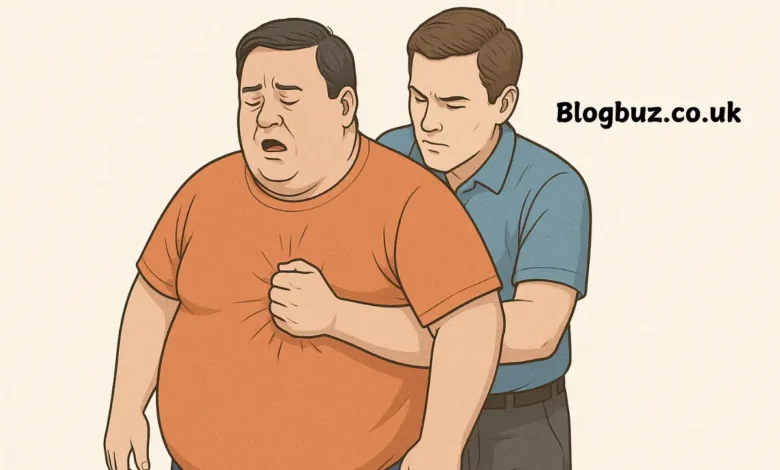What to Do If a Choking Victim Is Too Large: Life-Saving Techniques for All Body Types

Choking is a life-threatening calamity that can happen to anyone, anytime, anywhere. While the Heimlich maneuver (abdominal thrusts) is a well-known technique for dislodging an obstruction in a choking victim’s airway, it may not be feasible for everyone. This raises a critical question: what do you do if a choking victim is too large to perform abdominal thrusts on? Whether due to obesity, pregnancy, or mobility limitations, knowing the correct method for assisting a larger individual can save lives. In this exhaustive guide, we will explore the causes of choking, standard procedures for choking rescue, and, most importantly, the proper techniques to use when a victim is too large for traditional methods. This article is beneficial for caregivers, first responders, restaurant staff, and anyone who wants to be prepared for real-life emergencies.
Understanding Choking and Its Risks
Choking occurs when an object blocks the airway, preventing air from reaching the lungs. Common causes include food, small toys, or other foreign objects. Signs of choking include:
- Inability to speak or cry out
- Difficulty breathing or noisy breathing
- Weak or no coughing
- Skin turning blue (cyanosis)
- Loss of consciousness
Immediate action is necessary to prevent brain damage or death, which can occur within minutes of oxygen deprivation.
Standard Choking Rescue Techniques
Under normal circumstances, the American Red Cross and American Heart Association recommend a combination of five back blows followed by five abdominal thrusts (commonly known as the Heimlich maneuver) for conscious choking victims. Here is a quick overview:
- Back Blows: Bend the person forward slightly. Give five firm blows between the shoulder blades with the heel of your hand.
- Abdominal Thrusts: Stand behind the person, wrap your arms around their waist, create a fist with one hand, position it just above the navel, grasp it with your other hand and execute quick upward thrusts.
Repeat the cycle of five back strikes and five abdominal thrusts until the object is discharged or the person becomes unconscious.
What If a Choking Victim Is Too Large for Abdominal Thrusts?
When the victim is too large or obese, it might not be possible to wrap your arms around your waist to perform abdominal thrusts. In such cases, chest thrusts are recommended as an alternative method.
Chest Thrust Technique for Larger Choking Victims
Follow these steps if you are unable to perform abdominal thrusts due to the person’s size:
- Position Yourself Properly: Stand directly behind the person and place your arms under their armpits.
- Hand Placement: Make a fist and position it on the center of the chest, on the lower half of the breastbone (sternum). Be careful to avoid the lower tip of the sternum (xiphoid process) to prevent injury.
- Perform Thrusts: Grasp your fist with the other hand and deliver quick, inward thrusts. These thrusts should be forceful enough to create a burst of air from the lungs to dislodge the object.
When to Use Chest Thrusts
- If the victim is obese and your arms can’t wrap around their waist
- If the victim is pregnant
- If the victim has abdominal injuries
- If you’re physically unable to perform abdominal thrusts
Unconscious Choking Victim
If the victim becomes unresponsive:
- Call for Emergency Help: Dial emergency services immediately (e.g., 911).
- Start CPR: Place the victim on a firm, flat surface. Begin chest compressions by placing the heel of your hand on the center of the chest and pressing down hard and rapidly (at least 2 inches deep and at a rate of 100-120 compressions per minute).
- Check the Airway: After every set of 30 compressions, open the mouth and check for visible objects. If seen, remove them carefully.
- Rescue Breaths: If trained, provide two rescue breaths after every set of compressions.
Continue CPR until professional assistance arrives or the person starts breathing.
Special Considerations for Caregivers and First Responders
- Know the Weight Limitations: Be aware of your physical limitations. If you cannot lift or reach around the victim, immediately call for help and try to use chest thrusts instead.
- Stay Calm: Panic can hinder your ability to perform life-saving procedures. Take a deep breath and act quickly but with confidence.
- Encourage Coughing: If the person can still breathe or speak, encourage them to cough forcefully.
- Never Perform Blind Finger Sweeps: Doing so can push the object further down the airway.
Preventing Choking in At-Risk Individuals
Choking is more likely in specific populations, including:
- Elderly individuals
- People with swallowing disorders (dysphagia)
- Small children
- People with obesity or reduced mobility
Tips to prevent choking include:
- Cut food into small, manageable pieces
- Avoid talking or laughing while eating
- Supervise children during meals
- Educate high-risk individuals and caregivers about proper chewing techniques
Training and Certification
One of the best ways to be prepared is to take a CPR and First Aid course certified by organizations like:
- American Red Cross
- American Heart Association
- National Safety Council
These courses often include hands-on training in performing chest thrusts and managing choking in special populations.
Conclusion
Choking emergencies can be terrifying, especially when the standard rescue techniques are not applicable due to the victim’s size. Understanding how to perform chest thrusts when a choking victim is too large for abdominal thrusts can be the difference between life and death. By being informed, staying calm, and acting quickly, you can provide life-saving assistance in critical moments.
FAQs
What should I do if I can’t wrap my arms around a choking victim?
Use chest thrusts instead of abdominal thrusts to help dislodge the object.
Are chest thrusts safe for pregnant or obese individuals who are choking?
Yes, chest thrusts are recommended for pregnant, obese, or anyone you can’t reach around safely.
What are the main signs that someone is choking and needs help?
Inability to speak, difficulty breathing, weak coughing, or blue skin are all signs of choking.
Can I perform the Heimlich maneuver on someone sitting or in a wheelchair?
Yes, adapt the technique using chest thrusts or abdominal thrusts as appropriate.
Should I try to remove an object from a choking victim’s mouth with my fingers?
Only remove visible objects; never perform a blind finger sweep, as it may drive the object further in.
You May Also Read: Zepbund: The Revolutionary Weight Loss and Obesity Treatment Drug




